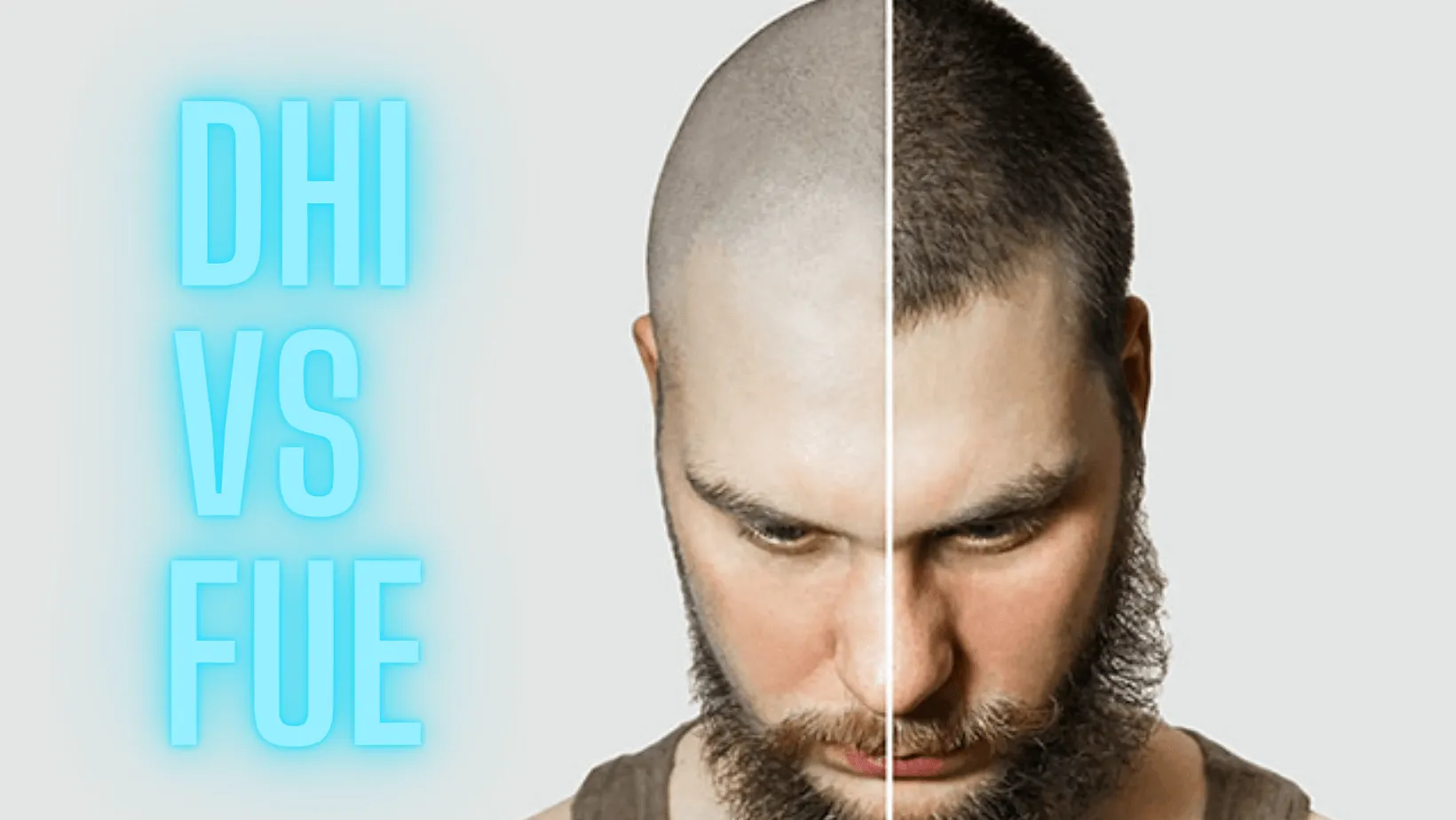FUE VS DHI What’s the difference? Which is best?
The two most popular type of hair transplant procedures is Direct hair implantation (DHI) and Follicular Unit Extraction (FUE). Each has its own special benefits. It’s worth considering the differences between the two before you choose a hair transplant clinic.
The main difference between DHI and FUE is the way in which the hair grafts are implanted into the skin. FUE uses small manually cut incisions whereas DHI uses a special pen-like tool to insert the grafts.
What is FUE Hair Transplant?
FUE (follicular unit extraction) is a technique where individual follicles are extracted from the donor area and transplanted into the recipient area. Little slits are made into the skin by the doctor, and grafts of hair are then inserted into the skin or scalp.
FUE hair transplant surgery is a fairly popular procedure today, and many patients choose it. FUE grafts are made directly from the scalp, as opposed to the traditional FUT (or Follicular Unit Transplantation) procedure, which involves removing a strip of skin to gather the grafts. The fact that the FUE treatment leaves no visible scars and produces natural-looking results is the most crucial consideration.
The first step in FUE hair transplant surgery is to manually remove groups of 1-4 hair follicles, known as grafts, one by one and store them in a storage solution. When the extraction phase has been completed, the doctor uses micro blades to widen the channels.
Patients who have had FUE hair transplant surgery should expect to see hair growth results on average two months after the procedure.
More significant growth will be noticed after a 6 month period, we a full result expected at around 12-18 months.
What is DHI Hair Transplant?
DHI (direct hair implantation) involves implanting hair into the head using a specialist pen. Grafts of up to five hairs and injected into the scalp at once using a special tool rather than manually creating slits into the scalp.
The hair follicles are removed one by one with a specialised tool with a diameter of 1 mm or less in the first step.
The hair follicles are then loaded onto a device called the Choi Implanter Pen, and the process is carried out by implanting them directly into the recipient area using the pen. It kind of injects groups of hairs known as grafts directly into the scalp. This gives the docter a lot of control over the placement of the hairs.
It also allows for more comfortable control over the angle, direction, and depth of newly transplanted hair. DHI also has a similar recovery time to FUE. It normally takes between 12 and 18 months. In fact the type of hair transplant procedure does not affect the hair regrowth time at all.
What is a Sapphire FUE hair transplant?
Sapphire refers to the blades that are used during a FUE hair transplant procedure. Sapphire blades are made from a single crystal that is synthetic sapphire.
The depth and width of the incisions are very even during sapphire hair transplantation, which is one of the most significant benefits. To avoid incisions (channels) that are too deep or shallow, the hair transplantation success rate is reduced in this manner. Around 5000-6000 grafts are transplanted per session with the Sapphire FUE technique, while 1500-3500 grafts can be transplanted every session with the DHI technique.
FUE VS FUT
The main difference between FUE and FUT is with FUT a strip of skin is cut from the back of the head containing hair. Whereas in FUE the individual follicular units are extracted directly from the scalp.
Which is better DHI or FUE?
Each type of transplant method is used in different scenarios and creates different looks. Therefore it’s better to use a combination of DHI and FUE.
Is FUE or DHI better for a beard transplant?
DHI is considered to be a better transplant procedure for a beard because of the angle the hair grafts can be inserted at. The angle of insertion helps creates a more natural beard appearance.
What is the recovery time of FUE hair transplant?
The recovery time of a FUE hair transplant is 7-14 days. With partial hair regrowth is expected within 6 months.
What is the recovery time of DHI hair transplant?
The recovery time of a DHI hair transplant is 7-14 days. With partial hair regrowth is expected within 6 months.
What percentage of Dhi grafts survive?
Its impossible to know how many grafts will survive, but studies have estimated this to be a 90% survival rate on average.
Which hair transplant method is best for avoiding scaring?
FUE, FUT and DHI can all leave scaring, it’s actually the quality of the doctor and clinic itself which will affect your chances of avoiding scaring.
Is fue the same as dhi?
FUE and DHI are similar with the main difference being the method of inserting the grafts. In general most clinics will use both techniques.
Does DHI damage existing hair?
There is no universal answer to this question, as the effects of DHI on hair may vary depending on the individual’s hair type and other factors. However, it is generally agreed that exposure to DHI may damage hair shafts and cause gradual loss of hair over time. This may be more pronounced in hair that is already thin and/or chemically treated. Additionally, DHI may also cause scalp irritation and dandruff. If you are concerned about the potential damage to your hair, it is important to consult a dermatologist who can recommend the best course of action for you.
Conclusion
DHI is a modified version of FUE hair implantation. Currently, there is no research available on the effectiveness of DHI specifically, but all types of FUE surgery have the potential to treat hair loss caused by male or female pattern baldness.
It is a relatively expensive procedure to have hair implants. In cases where you cannot afford surgery or do not have access to it, you might consider alternatives such as Rogaine or Finasteride tablets.

